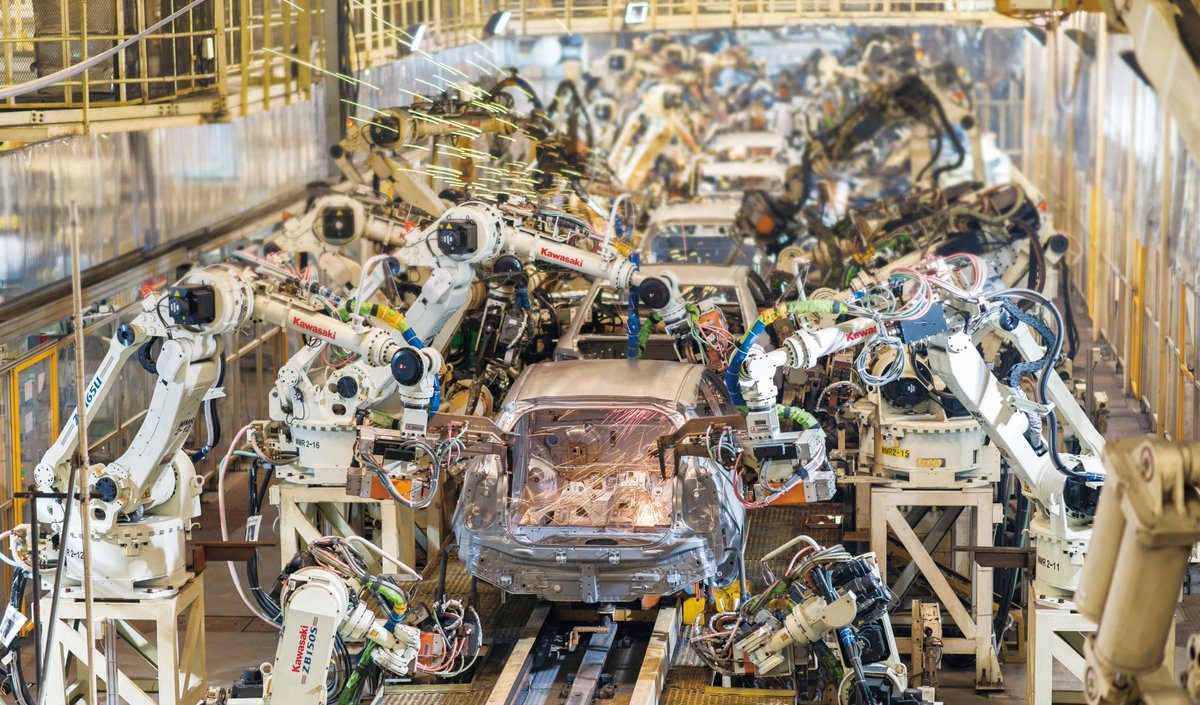Back in the 90s, the bestselling book The Machine That Changed the World revealed Japan’s expertise on lean production. It inspired many manufacturers to follow Toyota’s then production strategy, popularly known as Toyota Production System (TPS). Although Toyota has come a long way since then, the essential element of emphasizing on human craftsmanship is still strongly imbibed in Toyota’s manufacturing. Toyota balances the responsibilities of automated technology with human workers. Toyota’s factory in Georgetown, Kentucky combines the convenience of automation robots and the unique capabilities of human employees.
As an example, Georgetown’s factory workers designed a multi-armed industrial machine able to lift a gas tank in one motion before securing it in a crevice. The machine’s reach extends below the vehicle skeletal body and then attaches the tank permanently onto the chassis. But the machine did not take away the designers’ jobs. The company created new responsibilities for their workers as a result of the machine’s creation. The workers now triple check for tank flaws in the connections, which includes tactile and visual inspections.
Unlike other manufacturers that prefer to replace human workers with automation, Toyota ensures its employees are central to the entire manufacturing process. Toyota’s updated manufacturing system called The Toyota New Global Architecture (TNGA) epitomizes this balanced machine-human approach instead of brute automation that almost every other car manufacturer focuses on these days. According to Kentucky’s Toyota Manufacturing president, their current automation ratio isn’t any higher than what it was 15 years ago. Within Toyota’s global assembly line, robots cover less than 8% of the work. Machine capabilities are limited to repetitive tasks, James said. Unlike people, machines do not have the ability to improve their work quality or efficiency. Internal studies within Toyota have also shown that human labor consumes less time for car assembly over machines.
TNGA’s Contrarian Approach
The rest of the manufacturing industry is looking towards total dependence on robotics. Other auto companies like Korea-based Kia have outpaced other carmakers in the use of robots. Kia claims to have 200% productivity improvements entirely from automation. Automation is predicted to replace 47% jobs in the next two decades, at least according to this Oxford University analysis. The percentage is predicted even higher in China at 77% and at 69% for India. Elon Musk intends to remove human labor from his Model 3 Tesla plant.
While the rest of the manufacturing industry prefers to move with more robotics and automation, Toyota’s production principles firmly believe in the indispensable talents of people in the assembly line. Toyota has maintained more than 8% profit margins, placing the company in competition for the top spot in worldwide sales.
TNGA is one way for Toyota to get ahead. Unlike other manufacturing companies that cut costs through automation, Toyota does not remove human labor from its production expenses. Instead, they focus on using materials smartly, such as lighter and more compact component parts and a more economical sharing of vehicle and engine models worldwide. This approach also looks into process improvements, such as having zero downtime while assembly lines produce cars in succession. Robots are enablers and handmaidens to every employee in the assembly line.
The Legacy of Taiichi Ohno
In 2015, Toyota appointed automaker Mitsuru Kawai to an executive position. His 52 years in the company and blue-collar beginnings make him one of Toyota’s last connections to Taiichi Ohno, the godfather of lean manufacturing. Ohno is also the godfather of Toyota’s production system. He believed the experience and practice of individual workers are keys to an organization’s success. Kawai will be in charge of returning Ohno’s belief in human craftsmanship into TNGA. He says that humans still need to produce goods manually and maintain the process as simple as possible. Kawai added that machines can only take over when the process is “thoroughly simplified.”
Setting Up the TNGA Foundations
Before Toyota sets up TNGA globally, it has been executing different strategies of the approach in different factories. An investment of $1.3 billion has been given to renovate the Georgetown factory, which annually produces 550,000 Avalons, Camrys, and Lexuses. This move will be the pilot test before applying TNGA worldwide.
Apart from the previously described machine, the Kentucky site has replaced their overhead conveyor belts for moving pedestals. Designed to be the new engine delivery system, electronic sensors on the floor allow the pedestals to skate throughout the factory. As a result, plants can downsize accordingly with the removal of conveyor belts. The factory also ends up saving on other expenses such as maintenance, heating, real estate, and construction. The highly flexible and efficient system theoretically allows the plant to produce three SUVs for every sedan in an hour and the opposite the next hour.
These machines make assemblers more efficient as well. They end up spending less than a minute to check for defects. Another TNGA effort involves a karakuri assignment for assemblers. Workers are coming up with a Rube Goldberg-inspired contraption that could significantly improve the workspace activity. This requirement has led to a team re-engineering a flow rack so that workers no longer have to empty shelves manually and replace their parts.
Moving Towards a Productive Future
With this plan in motion, Toyota predicts reducing their manufacturing expenses by 40%. They intend not to increase production too quickly at the cost of manufacturing controls, quality, and factory productivity. Resulting from a slight lax in quality, in the period from 2009-2011, Toyota recalled over 9 million cars due to acceleration accidents.
TNGA is the company’s way of addressing and avoiding such a mistake. Kawai has also called for manual workspaces within critical plant processes. This includes the removal of automation from its previous installations when Toyota was going past its production capacity. Kawai has two goals in mind for these actions. The first is to maintain the skills and expertise of workers. Limiting their knowledge to small assembly roles will stop them from making improvements. The second involves seeing each factory site with a new vision. Toyota has to see if robots are really improving efficiency in every plant activity.
TNGA may seem radical in the age of automation but many are too quick to assume technology can replace human labor. Toyota’s vision shows the creation of new jobs with the addition of machinery. The rise of ATMs also shows how machines don’t replace employees like tellers. As technologies continue to advance, companies need to consider how to best leverage automation and other technologies without relegating human craftsmanship to the background.


















